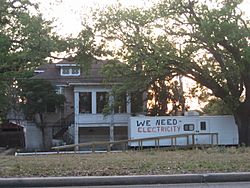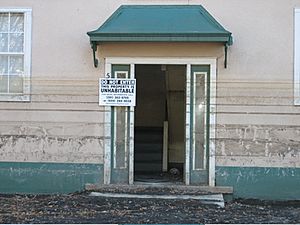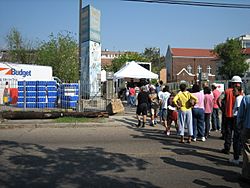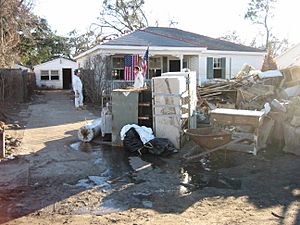Reconstruction of New Orleans facts for kids
The reconstruction of New Orleans refers to the rebuilding process endured by the city of New Orleans after Hurricane Katrina destroyed much of the city on August 29, 2005. The storm caused levees to fail, releasing tens of billions of gallons of water. The levee failure contributed to extensive flooding in the New Orleans area and surrounding parishes. About 80% of all structures in Orleans Parish sustained water damage. Over 204,000 homes were damaged or destroyed, and more than 800,000 citizens displaced—the greatest displacement in the United States since the Dust Bowl of the 1930s. Wind damage was less severe than predicted. The damage that took place that needed to be repaired cost about $125 billion.
Reconstruction was hindered by bureaucratic problems and funding issues with the U.S. Army Corps of Engineers and the Federal Emergency Management Agency (FEMA). Relief agencies provided supplemental relief. By mid-June 2006, the city was again hosting conventions and promoting tourism.
Contents
Reconstruction
By Monday, September 5, 2005 power began to be restored to buildings in the central business district of New Orleans on a priority basis. By Tuesday, September 6, 2005 the Port of New Orleans, the biggest U.S. port in terms of tonnage handled, was able to receive and service relief ships. It was estimated that resumption of commercial shipments would take at least 14 days.
Levee and pump repairs
The Corps of Engineers repaired the 55 levee breaches including the Industrial Canal, 17th Street Canal, and London Avenue Canal since shortly after the storm, and continues to work on mitigating the risk posed by flooding.
Utilities
Testing found the flood waters were not unusual. The Louisiana Department of Environmental Quality and the U.S. Environmental Protection Agency (EPA) in March 2006 declared all parts of New Orleans safe; no soil was contaminated and the air quality was pure.
Water and sewage services were gradually restored. The first section of the city to have a "boil water" order lifted was in the high ground of the old crescent along the River from the French Quarter to old Carrollton on 6 October 2005. The last section of the city to have such an order lifted (a section of the Lower 9th Ward) was on 9 October 2006.
Federal funding debate
Some people, including former Speaker of the House Dennis Hastert, questioned whether federal funds should pay to rebuild New Orleans. Others consider New Orleans's unique cultural heritage and history to be as important to the United States as, for instance, Venice is to Italy; they maintain that to not rebuild and reoccupy the city would be an immeasurable loss in that regard. The Times-Picayune ran a front page editorial arguing for national help. It has been argued that since the US Army Corps of Engineers has had oversight over the levee system since the Great Mississippi Flood of 1927 and most of the destruction in the city occurred due to the levee failure, the federal government should be responsible for rebuilding. Senator Mary Landrieu said that Louisiana's off-shore petroleum leases generate billions of dollars in revenues for the federal government's general fund, more than would be needed to restore wetlands and upgrade levee/flood control for South Louisiana to withstand category 5 storms. She argued that the federal government should either earmark some of that income for such projects or allow Louisiana to keep a significant portion of that revenue so the state could take care of its needs itself.
Rebuilding, social justice, and community life
Frederic Schwartz, the architect selected by the citizens of New Orleans and the New Orleans City Planning Commission to re-plan one third of the city for 40% of its population explained how the opportunity for rebuilding the city could be a chance to strengthen social justice and community life:
The planning of cities in the face of disaster (natural and political) must reach beyond the band-aid of short-term recovery. Disaster offers a unique opportunity to rethink the planning and politics of our metro-regional areas -- it is a chance to redefine our cities and to reassert values of environmental care and social justice, of community building and especially of helping the poor with programs for quality, affordable, and sustainable housing.
As lead planners for District 4, the district that includes the "largest concentration of public housing in the city" (Iberville, St. Bernard, Lafitte, and B. W. Cooper), Schwartz challenged his team to make "every effort to involve the residents and the community in the planning effort," while ensuring that the design of the new housing "could maintain the look and feel of surrounding neighborhoods with a mix of both modern interpretation of historic typologies and new urbanist models."
Relief agencies
Relief agencies helped many returnees. The American Red Cross made a belated significant entry into the city in mid-September; and by the start of October had a number of relief centers set up around the city. These provided hot meals, packaged food, bottled water and other supplies like diapers, mops, and dust masks. The Salvation Army also had many stations giving food. Temporary free clinics provided some medical care. Towards the end of 2005, the relief centers were wound down, starting with those in functioning parts of the city. Red Cross meals continued at a much smaller scale into 2006 from trucks traveling around the worst-hit and poorest neighborhoods.
The Southern Baptist Convention sent feeding units to New Orleans and the Mississippi Gulf Coast the day after Katrina struck New Orleans. Since this time, the Southern Baptist Convention through its North American Mission Board established an ongoing project called Operation Noah Rebuild, (not to be confused with the Operation Noah sponsored by the City of New Orleans) which has hosted thousands of volunteers and teams from all over the United States. The volunteer teams helped in the reconstruction efforts in New Orleans and the surrounding parishes. First Baptist Church of New Orleans worked hand-in-hand with Habitat for Humanity with the Baptist Crossroads Project, in an effort to rebuild homes in the Upper Ninth Ward.
Food Not Bombs was active in providing food early after the disaster. A community kitchen was set up first in Washington Square in Faubourg Marigny; after a few months it was moved to a park by Bayou St. John before being closed down. A number of church groups and smaller charities set up aid stations for a time.
Common Ground Collective had two relief centers in the Ninth Ward of New Orleans, providing food, clothing, and a tool library. The larger center was in the Upper 9th Ward, with a smaller one in the worst hit part of the Lower 9th Ward. They also helped gutting houses.
The Church of Jesus Christ of Latter-day Saints began bringing in load after load of food and water for local members and residents to several areas of the city. Thousands of church members came in on rotating weekends to help clean up debris, gut houses and cut up fallen trees all over the city. In addition to the home repairs, the church full-time counselors were available to provide mental health assistance; and church employment centers — offices that aid with finding jobs — opened their doors to everyone, regardless of religion.
Habitat for Humanity has been active in building homes at an accelerated pace since the storm. Initially, the organization had volunteers gutting homes; but since returned to its primary mission of fighting poverty housing. Catholic Charities also was very active with volunteers repairing damaged houses and churches throughout the area. Camp Hope in Violet, LA housed volunteers in the Hurricane Katrina recovery effort of St. Bernard Parish since June 1, 2006.
Build Now is a non-profit organization that played an active part in bringing New Orleans families back home. The non-profit, a licensed and insured residential contractor, constructed site-built, elevated houses on hurricane-damaged lots. The homes reflect the style and quality of traditional New Orleans architecture. Build Now brought more than a dozen New Orleans families back home, to include construction around the Lakeview, Gentilly and the Upper and Lower Ninth Ward areas. The organization moved New Orleans families back home since beginning operations in 2008.
The Jazz Foundation of America is a non-profit organization that helped New Orleans musicians directly by paying the first month's rent for new homes, getting nearly $250,000 worth of donated instruments to musicians, giving pro bono counseling, advocacy, legal counseling, and creating a long term employment program that put displaced musicians back to work performing free concerts in schools and nursing homes, in eight states. In 2005 The foundation held an auction to benefit musicians effected by Hurricane Katrina Thanks to the generosity of the foundation's chairwoman, Ms. Agnes Varis, they were able to create employment programs which have made it possible to keep the artists and their music alive in New Orleans.
Repopulation and restoring homes
Repopulating the city has been steady but gradual, with neither the rapid return of most evacuees hoped for by some optimists nor the long term "ghost town" desertion of the city feared by some pessimists. In early 2006, the RAND Corporation estimated that, even in 2008, the city's population would only be little more than half what it was before the storm hit; however by July 2007 the city's population was estimated at about 2/3 (or close to 300,000 residents) of that before the disaster.
Even in 2009, many homes and homeowners were still devastated. Some organizations, like the statewide Louisiana Disaster Relief Foundation or the neighborhood-based United Saints Recovery Project are still working to provide support to homeowners in rebuilding their homes.
The areas with little or no flooding were the first to be officially reopened, have utilities restored, and a sizable portion of residents and businesses return.
Flooded-out areas presented more problems. The city had no comprehensive plan for what to do about flooded areas. Thousands of property owners have been gutting and repairing their property, some in the lowest lying areas of town. Contractors and workers from out-of-state and other countries came in great numbers doing demolition and reconstruction work, some filling hotels and rental property, others living in trailers and tent cities set up in city parks and parking lots. Sportscaster Mike Tirico incorrectly generalized on Monday Night Football in September 2006, some areas, like the Lower Ninth Ward and Gentilly, still looked as badly damaged as the day the storm passed through. However, in each of those neighborhoods thousands of truckloads of debris were removed, hundreds of unsalvageable houses demolished, and work on gutting and repairs has been constant since the city has reopened.
Hundreds, if not thousands, of New Orleanians lived in the largely intact upper stories of their homes while the flood damaged downstairs got repaired, often being stripped to the wall joists in the process.
The U.S. Army Corps of Engineers set up the "Blue Roof Program" of putting blue tarps over damaged roofs. The tarps kept out rain until more permanent roof repairs could be made. Thousands of blue tarps were seen throughout the city; however, a number of official restrictions meant some residents were unable to benefit from this recovery program. Likewise, a number of subcontractors paid by the Corps only did "easy" low-pitch one-story roofs, choosing not to return to do more difficult roofs.

Seven months after the storm, two-thirds of the requested FEMA trailers (designed for short term emergency housing immediately after a disaster) had been delivered. Many of these trailers, however, could not be occupied or, if occupied, were not properly functional. Delays of weeks or months in hooking up electricity and water to trailers were common, and mechanical and bureaucratic problems prevented use of the trailers.
In June 2006, the State of Louisiana finally awarded a contract to DRC, Inc. of Mobile, Alabama to remove thousands of abandoned cars strewn throughout New Orleans after Hurricane Katrina.
Differing circumstances
Reconstruction has been easiest and quickest in the areas least damaged by the storm, mostly corresponding to the parts of the city developed before about 1900. These areas were built on naturally higher ground along the River front (such as Old Carrollton, Uptown, the Old Warehouse District, the French Quarter, Old Marigny, and Bywater), along with areas along natural ridges (such as Esplanade Ridge, Bayou St. John, Gentilly Ridge). Most of these older areas had no flooding at all or escaped serious flooding because of the raised design of older architecture which prevented floodwaters from entering homes. Another high area, much of which escaped serious flooding, was the set of Lake Shore developments between Lake Pontchartrain and Robert E. Lee Boulevard, built at a higher level than nearby land from mid-20th century dredging.
Due to the direction of the storm and the movement of storm surge, the West Bank section of the city, Algiers was spared flooding and became the first part of the city itself to officially reopen to residents.
In neighboring Jefferson Parish, the West Bank communities were similarly spared all but some wind damage (with a few spots of minor rain-generated flooding). On the East Bank, while parts of Metairie and other Jefferson communities experienced some flooding, due to lack of levee breaches this was much less severe than across the Parish line in Orleans (or the devastation of the 1947 Fort Lauderdale Hurricane which flooded most of Jefferson's East Bank).
Reconstruction of each section of the area has been addressed in the Army Corps LACPR Final Technical Report which identifies areas to not be rebuilt and areas buildings need to be elevated. The Technical Report includes locations of possible new levees; suggested existing levee modifications; "Inundation Zones"; "Water depths less than 14 feet, Raise-In-Place of Structures"; "Water depths greater than 14 feet, Buyout of Structures"; "Velocity Zones"; and "Buyout of Structures" areas for five different scenarios. The Corps of Engineers will submit the report to Congress for consideration, planning, and response in mid-2009.
A larger percentage of white residents returned to their homes than did black residents. This was attributed to an unwillingness of planners to rebuild low-income housing. In September 2005, the Washington Post noted former 10-term Republican Congressman Richard H. Baker from Baton Rouge reportedly told lobbyists, "We finally cleaned up public housing in New Orleans. We couldn't do it, but God did", and criticized his lack of concern for the lower income residents.
FEMA caseworkers were charged with the responsibility of helping evacuees find housing and employment. Caseworkers had to help some former residents realize that moving back was unrealistic because some of the city was not being rebuilt. This created a diaspora as many evacuees wished to return to New Orleans but were not able to.
Large areas of the city's public housing were targeted for demolition, inciting vocal protests from some, including architecture critic Nicolai Ouroussoff.
Homeless residents
A challenge facing New Orleans was the exceptionally large homeless population created by Katrina. The number of homeless people living in New Orleans doubled to 12,000 people between the hurricane and mid-2007. With a post-Katrina population of 300,000 people, this meant that 1 in 25 people were homeless, an extremely high number and nearly three times that of any other US city. Most of the homeless were Katrina evacuees who returned to higher rents or who fell through the cracks of the federal system that was to provide temporary housing after the disaster. There were also some workers who came from out of state for the post-Katrina rebuilding boom but who subsequently lost their jobs. Compounding this problem, the number of beds for the homeless in the city decreased from a count of 2,800 before the storm, to 2,000, as of May 2008.
The New Orleans Legal Assistance Corporation's Homeless Department worked overtime in January 2009 and reevaluated the homelessness rate. They found that the post-Katrina homeless population decreased by 64% since the last survey two years previously.
Tourism and events
The American Library Association held its annual convention in New Orleans in June 2006; the estimated 18,000 attendees represented the first city-wide convention in New Orleans since Hurricane Katrina. The National Association of Realtors also held their annual convention in New Orleans bringing 30,000 attendees to the city in November 2006. The HIMSS healthcare information technology convention and the American College of Cardiology convention, both held in the spring of 2007, each had more than 24,000 attendees. The Essence Music Festival returned to the Crescent City in July 2007 after being displaced to Houston in 2006. Several national travel guides have once again listed New Orleans as one of the top five places to visit in the country.
The Bayou Classic, the traditional football game between Southern University and Grambling State University, returned in November 2006 after being displaced to Houston for its 2005 game. The National Football League made a commitment to the city with the return of the New Orleans Saints, following speculation about a move to San Antonio or Los Angeles. The National Basketball Association has made a commitment with the return of the New Orleans Hornets, which played in both New Orleans and Oklahoma City, in the 2005–06 and 2006–07 seasons, returning fully for the 2007–08 season. (Oklahoma City became a permanent member of the NBA in the 2007–08 season.) New Orleans was granted the 2008 NBA All Star Game, which usually generates millions of dollars in revenue for the host city. Tulane University hosted the first and second rounds of the 2007 NCAA Men's Division I Basketball Championship.
The Superdome has since hosted several college football bowl games. The New Orleans Bowl resumed in December 2006, and the Sugar Bowl and 2008 BCS National Championship Game took in January 2008. New Orleans hosted the Super Bowl in 2013 for the first time since Hurricane Katrina. On February 2010, the New Orleans Saints won Super Bowl XLIV. There is heavy speculation that New Orleans plans to bid on hosting the Olympics, but they would bid for the 2024 Games at the earliest.
In mid-March 2007 a local group of investors began conducting a study to see if the city could support a Major League Soccer team.
Major seasonal events such as New Orleans Mardi Gras and the Jazz and Heritage Festival were never displaced, occurring at other times of year.
Images for kids
See also
 In Spanish: Reconstrucción de Nueva Orleans para niños
In Spanish: Reconstrucción de Nueva Orleans para niños










